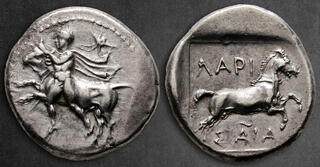| Savoca Numismatik GmbH & Co. KG > Online Auction 187 | Silver | Auction date: 10 December 2023 |
| Lot number: 26 Price realized: 460 EUR (Approx. 496 USD) Note: Prices do not include buyer's fees. | Show similar lots on CoinArchives Find similar lots in upcoming auctions on |
| Lot description: Thessaly. Larissa circa 400-380 BC. Drachm AR 19 mm, 6,05 g Thessalos, with cloak and petasos over his shoulders, leaping left, both feet on the ground, holding a rushing bull by a band around its head / ΛΑΡΙΣΑΙΑ, bridled horse with trailing rein galloping right; all within incuse square. Good Very Fine BCD Thessaly II, 372.5; Herrmann Group III H, pl. III, 20. Thessaly, an ancient region in Greece, holds a significant association with horses in Greek mythology and history. The fertile plains of Thessaly were renowned for breeding and producing exceptional horses, making them a central element in the region's cultural identity. In Greek mythology, Thessaly is often connected to the legendary figure of Centaurs, mythical beings with the upper body of a human and the lower body of a horse. The Centaurs were said to inhabit the mountainous and forested regions of Thessaly, embodying a wild and untamed nature. One of the most famous Centaurs, Chiron, was known for his wisdom, healing abilities, and gentleness, setting him apart from the more unruly members of his kind. Additionally, Thessaly played a crucial role in ancient Greek cavalry. The Thessalian cavalry was highly esteemed in the military, known for its skillful use of horses in battle. Thessalian cavalry units were employed by various Greek city-states, and their expertise contributed to the success of many military campaigns. The prominence of horses in Thessalian culture is also reflected in historical events. The Thessalian League, a confederation of Thessalian city-states, was a notable political and military force in ancient Greece, partly due to the strength of its cavalry. Starting price: 400 EUR |  |


